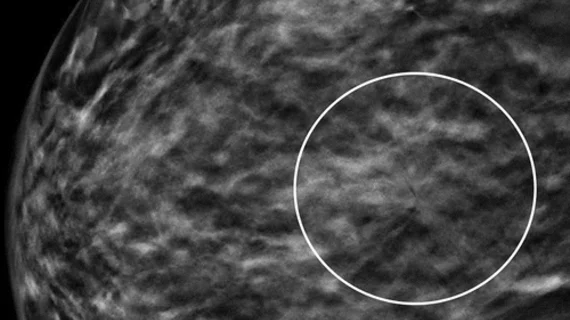Women with extremely dense breasts benefit most from DBT plus synthesized mammography
Higher rates of invasive cancers are detected via digital breast tomosynthesis (DBT) plus synthesized mammography in women with extremely dense breasts.
Compared to digital mammography, DBT plus synthesized mammography detected 2.7 more invasive cancers per 1,000 women included in the TOmosynthesis plus SYnthesized MAmmography (TOSYMA) study. Women who were categorized as having extremely dense breast tissue appeared have the most marked increase in detection, experts of a new paper published in Radiology shared.
“Extremely dense breast parenchyma is associated with an increased interval cancer rate, thus lower screening sensitivity,” the paper’s corresponding author Stefanie Weigel, from the Clinic for Radiology and Reference Center for Mammography Münster, University of Münster and University Hospital Münster in Germany, and colleagues explained. “Due to the generally poorer prognosis of interval carcinomas, strategies to improve screening performance are of great importance.”
DBT imaging has been proven beneficial in women with dense breasts due to its ability to produce multiple projections from a single acquisition. Synthesized mammography (SM) reconstructs two-dimensional images from the DBT dataset and has been proposed as an alternative to DM in women who would benefit from a combination of DBT and DM exams.
The study compared differences in invasive breast cancer detection rates (iCDR) between women who underwent DBT plus SM and DBT plus DM. The subanalysis included more than 99,000 women divided evenly between the two exams. Breast density was categorized from A-D, with category A indicating that the tissue was almost entirely fatty and category D indicating extremely dense breasts.
The DM arm detected 2.3 invasive cancers per 1,000 women with extremely dense breasts. In comparison, the SM arm detected 8.3 per 1,000 for category D.
“Although there is no consensus on the optimal approach, the TOSYMA trial results may suggest that especially women with extremely dense breasts could benefit from a transition from DM to DBT plus SM screening,” the authors wrote, adding that the limited sensitivity yielded by DM in women with extremely dense breasts could be overcome by switching to DBT plus SM.
To learn more, click here.

